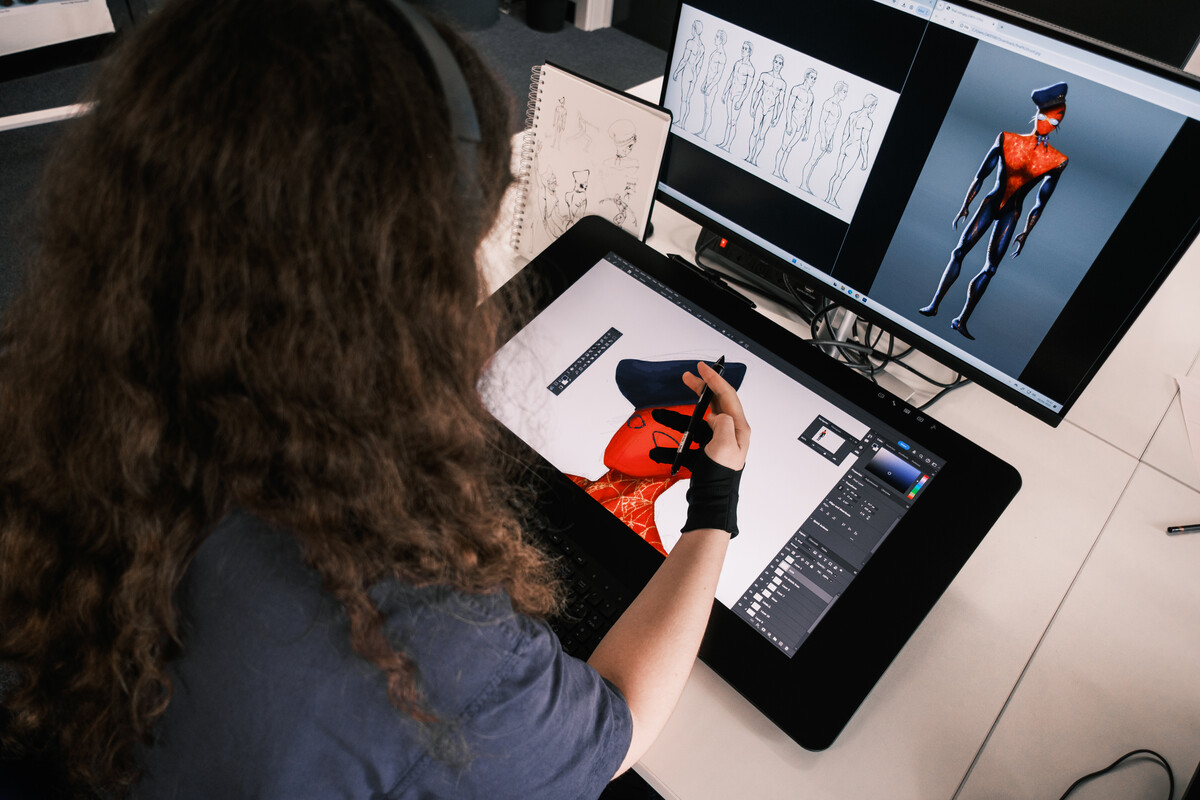Your portfolio is your chance to show admissions tutors your creativity, technical ability and, above all else, your passion for animation.
To create a strong animation portfolio, you shouldn’t just showcase final pieces; it should reflect your process and storytelling ability.
In this guide, we’ll cover everything you need to know to create a stand-out animation portfolio, including:
- What is an animation portfolio?
- What should you include in an animation portfolio?
- Top tips for building a stand-out animation portfolio
- How to present your animation portfolio
- What are admissions tutors looking for in an animation portfolio?
What is an animation portfolio?
An animation portfolio is well-organised selection of work that best demonstrates your ability to think creatively and tell stories.
It’s not just a showreel of your completed animations, as it should also include sketches, storyboards, and any other work that shows how you explore your ideas and refine them. A good portfolio is also reflective. Notes or discussion that analyses the work undertaken can demonstrate what you’ve learnt from a project.
Think of your portfolio as a story of who you are as an artist.
/prod01/channel_8/media/marketing-media/student-work/undergrad-courses/animation/2024/Matilda-Horton_-BA-_Hons_-Animation_-UCA-Farnham.jpg)
What should you include in an animation portfolio?
Your portfolio should demonstrate your technical skills and creative thinking.
Whilst showcasing your best work is important, you should also consider including items that you don’t think is as high in quality if the story of the work helps showcase what you’re capable of.
Here are key elements to consider:
- Sketches and concept art: polished concepts and rough sketches of character designs, environments and props.
- Storyboards: storyboards, even if just short sequences, can reveal your understanding of visual storytelling, pacing, and show composition.
- Animation tests: examples of movement, whether hand-drawn, digital or stop-motion, will demonstrate your grasp of timing and how different objects should move.
- Life drawing: observational drawing is a key skill for animators. Any drawings you have of people or animals that show your understanding of anatomy and motion will be of keen interest.
- Personal projects: anything that demonstrates that you’re able to visualise your own original ideas and creativity.
- Development work: universities want to see your process, so make sure to include any sketches, notes, and previous iterations of finished pieces.
- Tools and skills: whether you’ve mastered them or not, ensure your portfolio includes examples of all digital and traditional tools and techniques that you have experience of using.
Top tips for building a stand-out animation portfolio
- Quality over quantity: select the work that best shows off your ability and creativity, rather than throwing in everything you’ve ever made. At UCA, for example, Animation tutors ask for 12-20 pieces, so you need to be selective about what you include.
- Show variety: include different techniques and styles, including various traditional, digital, experimental methods if you can, to demonstrate your versatility.
- Tell a story: organise your portfolio so it flows logically. Start with a strong piece and end on something memorable.
- Highlight your process: admissions tutors love to see how you develop ideas, so including your sketches and notes is just as valuable as the final animation.
- Keep it personal: work that reflects your unique style and interests will stand out more than exercises and recreations of existing works.
- Keep it current: once you’ve made it, keep on top of it. As your skills develop make sure to refresh the items in your portfolio. You never know when you’ll next need it.
/prod01/channel_8/media/marketing-media/student-work/undergrad-courses/animation/2024/Bill-Montague_-BA-_Hons_-Animation_-UCA-Farnham.jpg)
How to present your animation portfolio
Many universities will offer you a chance to present your portfolio at an interview or applicant day. For example, at UCA we invite any who's applied to visit the campus and discuss their portfolio with Animation academics.
If you aren’t able to attend in-person, most universities will offer you the chance to upload your portfolio online for admissions tutors to review.
To make sure they understand the story you’re trying to tell make sure that you:
- Upload any video files to platforms such as Vimeo or YouTube and set them as public or unlisted so that anyone can click the link and view the content.
- Use a clear folder structure and file naming convention to ensure tutors can easily navigate your portfolio without missing any work.
- Review the specific requirements outline by the universities you’ve applied to, otherwise you may find that they aren’t able to review all the work you provide to them.
- Test everything before you submit to make sure everything works as you expect it to.
What are admissions tutors looking for in a animation portfolio?
- Your creativity and originality: they want to see your ideas, not just your technical ability.
- Your process: how you develop and adapt ideas.
- Your storytelling ability: animation is about telling stories and tutors want to see how you bring ideas to life.
- Your passion: your portfolio should reflect genuine interest and enthusiasm for animation.
/prod01/channel_8/media/marketing-media/student-work/undergrad-courses/animation/2025/James-Doherty,-BA-(Hons)-Animation,-UCA-Farnham.jpg)
Portfolio advice for UCA animation applicants
Need more portfolio support?
Still unsure what to include? Come along to one of our upcoming Open Days where you can speak to our animation academics and Admissions Team in more detail about what they expect to see in your portfolio.
You can also use our Unibuddy chat platform to speak directly to current UCA students and ask them about their portfolio. For more inspiration you could also check out the work created by UCA architecture students via our online graduate showcase.
More advice for animation applicants
- How to write a great UCAS personal statement for an Animation degree
- What careers can you do with an animation degree?
/prod01/channel_8/media/marketing-media/student-work/postgraduate-courses/animation/2024/Yue-Ying---Animation---MA-Animation.jpg)
